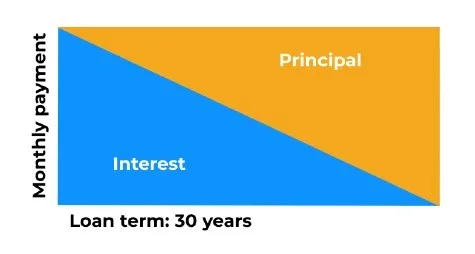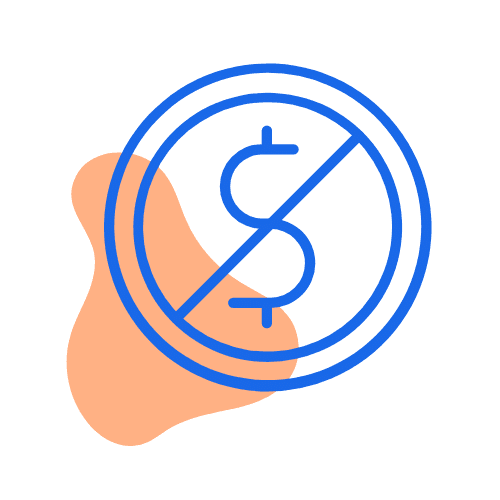
First homebuyer e-course
Sign up for our FREE 8-week course to get on the property ladder.
Home loans with principal and interest repayments are the most common home loan type in Australia. Principal is just the money you've borrowed. You repay this, with interest charged by the lender on top. With principal and interest repayments you repay some of the loan amount and some interest at the same time. This means you reduce your overall debt with each repayment.
The less common alternative to principal and interest loans are interest-only loans. These have higher rates and cost more in the long run, but have lower repayments early on. They're popular with property investors and borrowers who want to temporarily reduce their repayments.
When you borrow money to buy a home, you have to repay it – obviously. The amount of money you've borrowed is called the loan principal (it's sometimes called the loan amount). You have to repay this money over time, but you also have to pay interest.
Interest is money charged on top of the loan principal. The amount of interest you pay is determined by your home loan's interest rate. The size of your loan principal also affects the amount of interest charged. The more you borrow, the more interest you pay.
Most home loans are principal and interest loans. With these loans, you repay the loan principal plus interest at the same time. Every month, you make repayments on your home loan. Part of the repayment is interest and part of it is principal.
Here's a simple example using Finder's home loan repayment calculator:
With this example, you're repaying $1,921 a month (assuming interest rates don't change). With interest charged on top, your $480,000 loan principal plus interest will end up costing you $691,787 over 30 years.
That's $211,787 in interest charges plus the original loan principal.
When you start making mortgage repayments, you might notice that most of your repayment is paying off the interest at the beginning of the loan. Only a small amount will go towards the principal. As you continue paying off the loan, you'll pay off more principal and less interest.
This is because your lender has worked out exactly how much you'll need to spend on each repayment to pay off your loan in the term you've agreed to. The result of these calculations is called an amortisation schedule. The schedule shows how much of your payments goes towards interest and how much goes towards the principal. The amount that goes towards paying off the principal gets bigger as the years go on and does so at a faster rate.
Here's a simple graph to illustrate how mortgage interest and principal are repaid together over time.

| Response | |
|---|---|
| Principal & interest | 61.36% |
| Interest only | 34.09% |
| Split | 4.55% |
Borrowers have an alternative to principal and interest repayments: interest only home loans. These loans have an initial period where the borrower doesn't repay the loan principal at all. Instead, they just pay the interest charges.
This makes their repayments smaller at first. But eventually, the loan will revert to principal and interest repayments, meaning you have to pay off the principal.
This means that interest only home loans start cheaper but end up being more expensive.
Here's an example using two loans. They are identical except that one is principal and interest while the other is interest only for the first three years.
| Details | Principal and interest | Interest only |
|---|---|---|
| Loan principal | $400,000 | $400,000 |
| Loan term | 30 years | 30 years |
| Interest rate | 2.45% | 2.45% |
| Interest only period | N/A | 3 years |
| Monthly repayments | $1,570 | $817 (during interest only period) $1,689 (after interest only period) |
| Total interest | $165,237 | $176,574 |
| Total loan cost over 30 years | $565,237 | $576,574 |
Here we can see that making interest only payments for 3 years ultimately costs you an extra $11,337 in interest.
Interest only loans are commonly used by investors to minimise their non-tax-deductible costs (interest charges on an investment property are tax deductible but principal payments are not).
This can be beneficial for investors planning to hold an investment property for a short time in a growth market. Instead of paying off the loan, these investors plan to see a quick capital growth (the value of the property rising) and then sell the property. With this strategy, an interest only loan allows the investor to minimise their repayments.
Some owner-occupiers choose to make interest only repayments for a short time if they are struggling to make repayments or have a reduced income.
You can use Finder's free home loan calculator to see how the principal and interest components of a home loan work.
Just enter some basic loan details, including loan amount (the principal) and an interest rate. In the repayment type field, you can select P&I (principal and interest) or interest only.
When comparing loans with principal and interest repayments, the interest rate is the first thing you should look at. The lower the interest rate, the lower your repayments will be.
But there's more to it than that:
A big advantage of principal and interest home loans is that you're repaying the loan principal from day one. This means you're not only paying off debt, you're building equity in your home (that's the value of your property minus any outstanding debts).
And if you can repay the loan faster, you'll get out of debt sooner and pay less in interest. There are several ways you can do this, and it depends on your loan's features:




The Homebuyer Fund allows Victorians to buy homes with 5% deposits in exchange for a share of the property.
Chris Gray takes us through four things people get wrong when buying property.
Auction expert Damien Cooley gives the lowdown on why property auctions are the best way to sell right now.
Richard Holden from UNSW Business School delves into Australian home loan sizes and rate cuts
We can't make clear predictions about Sydney's property market, but here's what the data suggests.
There's profit to be made in renovating your home, but don't jeopardise your insurance when you do.
The Freedom Lend Fixed Rate Home Loan combines a competitive fixed interest rate with no ongoing monthly or annual fees.
Australians are now drinking less than we previously were. Find out how you could save $40,000 by simply not drinking alcohol.
Compare current bank interest rates for home loans, credit cards, personal loans, savings accounts and term deposits to find the best deal for you.
What is an offset account? It can save you thousands in interest and help you own your home sooner.

Sign up for our FREE 8-week course to get on the property ladder.

Get a home loan with a low deposit.

Pay less for your home loan with a super-low interest rate.

Save on your investment loan with these hot offers.
Hey do banks tag on the interest charged on to the principal amount in a home loan
So if the interest is $400 on the loan and the repayments are $1800 in total
The 1400 is off the principle but the $400 is then added to the principle
I always see in my statement that the interest charged is put directly on to my outstanding principle so the banks are charging interest on the interest they charged! Compound interest I understand but can you clarify?
Hi Patrick,
This one is a tricky one to answer and you could probably email your lender and ask them for a breakdown in case they calculate it differently. But basically your lender charges interest on top of the principal and you pay back both over time. But it’s lopsided. You pay mainly interest up front and more off the loan principal over time. This is called an amortisation schedule.
I hope this helps.
All the best,
Richard